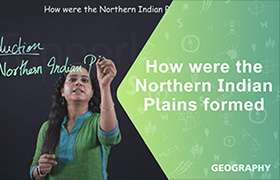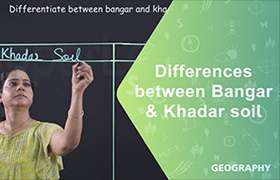CBSE Class 9 Answered
A short note on northern phases of india
Asked by Pranita | 13 Apr, 2017, 12:22: PM
Do you mean "a short note on northern plains of India"?
The northern plains have been formed by three major river systems—the Indus, the Ganga and the Brahmaputra. This plain has been formed of alluvial soil.The Northern Plains are divided into three parts. The western part of the Northern Plains is known as the Punjab Plains. The larger part of this plain lies in Pakistan. It is drained by the River Indus, and its tributaries are the Ravi, Beas, Satluj, Jhelum and Chenab. The Ganga Plain is spread over the states of Haryana, Delhi, UP, Bihar and some parts of Jharkhand
and West Bengal. Assam is part of the Brahmaputra plains. The Northern Plains present various relief features. They can be divided into four regions based on the
variations in relief features:
o When rivers come down from the mountains, they deposit pebbles in a narrow belt lying parallel to
the Siwaliks. This is called the Bhabar belt. All rivers disappear into this belt.
o To the south of the belt, the rivers and streams appear again and create the Terai region which is
wet, swampy and marshy.
and West Bengal. Assam is part of the Brahmaputra plains. The Northern Plains present various relief features. They can be divided into four regions based on the
variations in relief features:
o When rivers come down from the mountains, they deposit pebbles in a narrow belt lying parallel to
the Siwaliks. This is called the Bhabar belt. All rivers disappear into this belt.
o To the south of the belt, the rivers and streams appear again and create the Terai region which is
wet, swampy and marshy.
A large part of the Northern Plains is formed of the older alluvial soil and presents a terrace-like
feature. This is known as bhangar. Its soil consists of granules known as ‘kankar’.
o The newer deposits are known as ‘khadar’. These are so fertile that intensive cultivation is
practised here.A large part of the Northern Plains is formed of the older alluvial soil and presents a terrace-like feature. This is known as bhangar. Its soil consists of granules known as ‘kankar’.
o The newer deposits are known as ‘khadar’. These are so fertile that intensive cultivation is practised here.
feature. This is known as bhangar. Its soil consists of granules known as ‘kankar’.
o The newer deposits are known as ‘khadar’. These are so fertile that intensive cultivation is
practised here.A large part of the Northern Plains is formed of the older alluvial soil and presents a terrace-like feature. This is known as bhangar. Its soil consists of granules known as ‘kankar’.
o The newer deposits are known as ‘khadar’. These are so fertile that intensive cultivation is practised here.
Answered by Social Science Expert | 13 Apr, 2017, 10:44: PM
Application Videos
CBSE 9 - Geography
Asked by madhubalasingh876787 | 03 Nov, 2023, 07:32: PM
CBSE 9 - Geography
Asked by vasantipathak60 | 25 Jun, 2022, 12:03: PM
CBSE 9 - Geography
Asked by shuklaramakant.2016 | 24 Jun, 2022, 06:07: PM
CBSE 9 - Geography
Asked by surendrakumarchanda7 | 21 May, 2022, 11:04: AM
CBSE 9 - Geography
Asked by natiknonu1234riteshkumar | 08 Dec, 2021, 07:02: PM
CBSE 9 - Geography
Asked by frusbJusyktsnis | 09 Sep, 2021, 08:06: PM
CBSE 9 - Geography
Asked by deeptisingh832008 | 27 Jul, 2021, 08:39: PM
CBSE 9 - Geography
Asked by vedants017 | 10 Jul, 2021, 04:15: PM
CBSE 9 - Geography
Asked by sanjaykmrsn | 30 Jun, 2021, 04:40: PM
CBSE 9 - Geography
Asked by srimanmishra12 | 20 May, 2021, 11:03: AM






